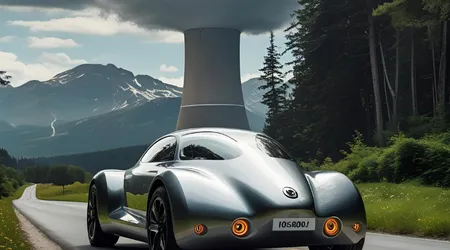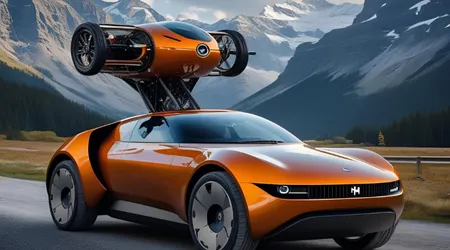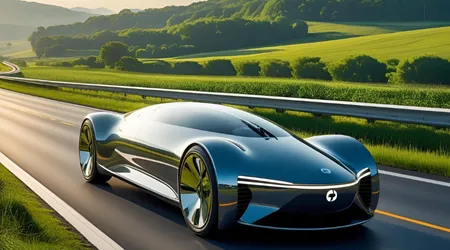The Car That Was Powered by Nuclear Energy (Yes, Really)
Anúncios
The idea of a car that was powered by nuclear energy sounds like it belongs in a sci-fi novel, conjuring images of glowing engines and limitless road trips.
Yet, in the 1950s, this concept was not just a fantasy but a bold vision of the future, embodied by designs like the Ford Nucleon.
This audacious attempt to harness nuclear fission for automotive propulsion captured the imagination of a post-war world enamored with the potential of atomic energy.
Anúncios
However, the dream of nuclear-powered cars, while innovative, faced insurmountable technical and ethical hurdles that kept it confined to concept sketches and scale models.
In this exploration, we’ll dive into the fascinating story of the car that was powered by nuclear energy, examining its historical context, technical ambitions, and the reasons it never hit the roads.
Furthermore, we’ll explore how this concept, though unrealized, continues to inspire modern discussions about alternative energy in transportation.
Could a nuclear-powered car ever become a reality, or is it destined to remain a relic of Atomic Age optimism?
Let’s unpack this intriguing chapter of automotive history with a critical and creative lens.
The Atomic Age and the Birth of the Nuclear Car

The 1950s were a time of unbridled optimism about nuclear energy, often dubbed the “Atomic Age.”
Following World War II, the devastating power of nuclear fission was redirected toward peaceful applications, from powering cities to propelling submarines.
++ The History of Ford: How the Brand Democratized the Automobile
Consequently, automakers like Ford saw an opportunity to revolutionize transportation by envisioning a car that was powered by nuclear energy.
The Ford Nucleon, unveiled in 1957 as a scale model, became the poster child for this ambition, promising a future where gasoline would be obsolete.
This vision wasn’t born in a vacuum.
The success of nuclear-powered submarines, such as the USS Nautilus launched in 1954, demonstrated that compact reactors could drive massive vehicles for extended periods without refueling.
Naturally, engineers speculated that similar technology could be scaled down for consumer cars.
The Nucleon’s design proposed a small nuclear reactor at the rear, using uranium fission to heat water into steam, which would then drive a turbine to power the vehicle.
Ford estimated that such a car could travel 5,000 miles before needing a reactor swap, a range that dwarfed the fuel efficiency of any gasoline-powered car of the era.
However, the optimism of the Atomic Age often glossed over practical realities.
The Nucleon was less a blueprint and more a speculative exercise, reflecting the era’s fascination with limitless energy.
While the concept captivated the public, it also raised questions about safety, cost, and feasibility that were impossible to ignore.
How could a car, meant for everyday commutes, manage the risks of radiation in a world not yet ready for such technology?
Technical Challenges: Why Nuclear Cars Stayed on Paper
The allure of a car that was powered by nuclear energy lay in its promise of unparalleled energy density.
A single pound of enriched uranium could theoretically power a vehicle for thousands of miles, far surpassing the efficiency of fossil fuels. Yet, the technical hurdles were daunting.
++ Cars Built to Break Records
For instance, nuclear reactors, even the smallest ones, required heavy shielding to protect drivers and passengers from radiation.
Studies from the 1950s estimated that a 50-ton lead barrier would be necessary to make a nuclear car safe, rendering it impractical for everyday use.
Moreover, the energy conversion process posed significant challenges.
Unlike internal combustion engines, which directly convert chemical energy into mechanical force, nuclear reactors generate heat that must be transformed into usable power through multiple steps.
In the Nucleon’s case, the reactor would heat water to produce steam, which would drive a turbine connected to an electric generator.
Each conversion step introduced inefficiencies, with energy lost as waste heat. Dr. L.
Dale Thomas, a systems engineering expert, noted that these conversions are “like currency exchanges at the airport you always lose.”
This inefficiency, combined with the need for radiators to dissipate excess heat, made the system cumbersome for a compact vehicle.
Safety concerns were equally prohibitive.
A car that was powered by nuclear energy would carry a radioactive core, raising the specter of catastrophic accidents.
Imagine a fender-bender escalating into a radiation leak an unacceptable risk for consumer vehicles.
Additionally, the infrastructure for refueling or swapping reactors didn’t exist, and the logistics of handling nuclear waste in a civilian context were nightmarish.
These challenges ensured that the Nucleon remained a scale model, now displayed at the Henry Ford Museum as a testament to bold but unfeasible dreams.
Car that was powered by nuclear energy: Index:
| Technical Challenge | Description | Impact on Feasibility |
|---|---|---|
| Radiation Shielding | Required heavy materials (e.g., 50 tons of lead) to protect occupants. | Made the car too heavy and impractical for consumer use. |
| Energy Conversion | Multiple steps (heat to steam to turbine to electricity) led to energy loss. | Reduced efficiency, requiring complex cooling systems. |
| Safety Risks | Potential for radiation leaks in accidents or malfunctions. | Posed significant public health and safety concerns. |
| Infrastructure | Lack of facilities for refueling or reactor swaps. | Made widespread adoption logistically impossible. |
Safety and Ethical Dilemmas: A Radioactive Roadblock
Beyond technical barriers, the ethical implications of a car that was powered by nuclear energy were profound.
The 1950s public was aware of nuclear risks, having witnessed the aftermath of Hiroshima and Nagasaki.
++ The Evolution of Automotive Safety Systems
The idea of millions of drivers operating miniature reactors raised fears of radiation exposure, especially in densely populated areas.
For example, a hypothetical crash involving a nuclear-powered car could release radioactive material, endangering not just the driver but entire communities.
Furthermore, the proliferation of nuclear materials posed a security risk.
Distributing uranium or other fissile materials to fuel stations would have required stringent oversight to prevent theft or misuse.
Consider a scenario where a terrorist group acquires nuclear fuel from a poorly secured refueling station such a possibility would have been a regulatory nightmare.
The Ford Nucleon’s designers optimistically assumed that lightweight shielding or even “force fields” might one day solve these issues, but such technologies remain science fiction even today.
On the other hand, proponents argued that nuclear cars could reduce reliance on fossil fuels, offering a cleaner alternative to gasoline.
In an era when environmental concerns were just emerging, the promise of zero-emission vehicles was tantalizing.
Yet, the environmental benefit was overshadowed by the challenge of nuclear waste disposal.
Unlike electric vehicles, which can leverage a centralized grid, nuclear cars would decentralize radioactive materials, complicating waste management.
Thus, the ethical trade-offs clean energy versus catastrophic risk tilted heavily against the concept.
Modern Reflections: Could Nuclear Cars Ever Work?
Fast forward to today, and the dream of a car that was powered by nuclear energy seems both nostalgic and far-fetched.
Advances in nuclear technology, such as small modular reactors (SMRs) and thorium-based systems, have made reactors smaller and safer, but they’re still too large and complex for automotive use.
For instance, modern SMRs can generate as little as one megawatt of power, suitable for small communities but not for fitting under a car’s hood.
The shielding problem persists, with even the most advanced designs requiring several feet of protective material.
However, nuclear energy could indirectly power transportation.
Nuclear power plants already supply about 20% of U.S. electricity, much of which charges electric vehicles (EVs).
This approach sidesteps the dangers of onboard reactors while leveraging nuclear’s low-carbon benefits.
Imagine a future where fast-charging stations, powered by SMRs, dot highways, enabling EVs to recharge in minutes.
This vision aligns with current research into nuclear-powered hydrogen production, which could fuel zero-emission vehicles without the risks of direct nuclear propulsion.
Interestingly, the concept of “atomic batteries” offers a glimpse of what a nuclear-powered car might look like today.
These devices, powered by the steady decay of isotopes like plutonium-238, produce small but consistent amounts of electricity with minimal waste.
Used in spacecraft like the Mars rovers, atomic batteries could theoretically power an ultra-efficient electric car for decades.
Yet, their high cost and limited power output make them impractical for mass production.
The question remains: why chase the complexity of nuclear cars when EVs, powered by a nuclear grid, already offer a practical path forward?
Car that was powered by nuclear energy: Index:
| Modern Nuclear Technology | Potential Application | Current Limitation |
|---|---|---|
| Small Modular Reactors (SMRs) | Could power EV charging stations or hydrogen production. | Too large and heavy for direct automotive use. |
| Thorium Reactors | Less radioactive fuel, potentially safer. | Still requires significant shielding and infrastructure. |
| Atomic Batteries | Long-lasting power for niche applications (e.g., spacecraft). | High cost and low power output limit consumer use. |
Creative Analogies and Examples: Envisioning the Nuclear Car

To grasp the audacity of a car that was powered by nuclear energy, consider it like a miniature sun trapped in a sedan.
Just as the sun fuels life through fusion, a nuclear car would harness fission to roam highways, radiating potential but constrained by its own volatility.
This analogy underscores the paradox: immense power comes with immense responsibility, and the risks of containing a “sun” on wheels were too great for 1950s technology or even today’s.
Example 1: The Eco-Nucleon of 2035
Imagine a futuristic city in 2035, where a startup unveils the Eco-Nucleon, a concept car powered by a microreactor using thorium.
The vehicle, sleek and silent, promises 10,000 miles of range with zero emissions. Its onboard AI monitors the reactor, automatically shutting it down in emergencies.
Charging stations, replaced by “reactor swap hubs,” use robotic arms to replace spent cores safely.
While technically feasible, the Eco-Nucleon faces public skepticism due to fears of radiation, echoing the challenges of the 1950s Nucleon.
Example 2: The Community Nuclear Hub
Picture a rural town in 2040, powered by a single SMR that supplies electricity to a fleet of electric buses.
These buses, indirectly nuclear-powered, serve as a modern reinterpretation of the Nucleon’s vision.
By centralizing the reactor, the town avoids the risks of onboard nuclear power while reaping the benefits of clean energy.
This model highlights how nuclear energy can support transportation without the dangers of individual reactors.
Statistical Insight: The Energy Density Advantage

A striking statistic underscores the allure of nuclear-powered cars: one gram of uranium-235 can release energy equivalent to 22,800 kWh, enough to power an electric car for over 100,000 miles under ideal conditions.
Compare this to gasoline, where a gallon (about 3.8 liters) provides roughly 33.7 kWh, enough for just 100-150 miles in an efficient vehicle.
This staggering energy density explains why engineers in the 1950s dreamed of nuclear cars, even if the practical barriers were insurmountable.
The Legacy of the Nuclear Car: Lessons for Today
The story of the car that was powered by nuclear energy is more than a historical curiosity; it’s a lesson in balancing ambition with pragmatism.
The Ford Nucleon and its contemporaries, like the Studebaker-Packard Astral, embodied the Atomic Age’s belief that technology could solve any problem.
Yet, their failure to materialize highlights the importance of aligning innovation with safety and feasibility.
Today, as we grapple with climate change, the Nucleon’s vision of clean, abundant energy resonates, but its execution remains flawed.
Instead of nuclear cars, the future lies in integrating nuclear energy into broader transportation systems.
Small modular reactors could power EV charging networks, while nuclear-derived hydrogen could fuel heavy vehicles like trucks and ships.
These indirect applications avoid the risks of onboard reactors while delivering the environmental benefits that the Nucleon’s designers envisioned.
The dream of limitless range persists, but it’s being realized through electric and hydrogen technologies rather than miniature reactors.
What can we learn from this bold but unrealized vision?
Perhaps it’s that innovation requires not just creativity but also humility.
The car that was powered by nuclear energy pushed the boundaries of what was possible, but it also reminded us that not every dream is meant to become reality.
As we look to the future, how can we harness nuclear energy’s potential without repeating the Nucleon’s overambitious missteps?
Frequently Asked Questions
| Question | Answer |
|---|---|
| What was the Ford Nucleon? | The Ford Nucleon was a 1957 concept car designed to be powered by a small nuclear reactor using uranium fission to generate steam for propulsion. It never progressed beyond a scale model due to technical and safety challenges. |
| Why didn’t nuclear-powered cars become reality? | They faced insurmountable issues, including heavy shielding requirements, inefficient energy conversion, safety risks from radiation, and lack of infrastructure for refueling or waste disposal. |
| Could nuclear-powered cars exist today? | Direct nuclear propulsion remains impractical due to size, safety, and cost. However, nuclear energy could indirectly power vehicles through EV charging or hydrogen production using modern reactors. |
| What are the environmental benefits of nuclear cars? | In theory, they could offer zero-emission driving with high energy density, reducing fossil fuel use. However, risks like radioactive waste and accident hazards outweigh these benefits. |
| Are there modern alternatives to nuclear cars? | Yes, electric vehicles powered by nuclear-generated electricity or hydrogen produced by nuclear reactors provide safer, more practical solutions for clean transportation. |
Conclusion: car that was powered by nuclear energy
The car that was powered by nuclear energy, epitomized by the Ford Nucleon, was a bold leap into an imagined future where energy was limitless and clean.
While it never left the drawing board, its legacy endures as a symbol of human ambition and the challenges of taming powerful technologies.
Today, as we navigate the transition to sustainable transportation, the Nucleon’s story reminds us to dream big but plan wisely.
By leveraging nuclear energy indirectly through EVs, hydrogen, or advanced batteries we can achieve the environmental goals that the Nucleon’s designers envisioned without its radioactive risks.
What bold visions will define the next era of transportation, and how will we ensure they’re grounded in reality?
